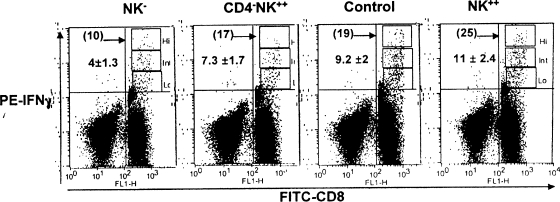FIG. 5.
NK cells contribute to higher IFN-γ production by anti-HSV CD8+ T cells. As described for Fig. 4, C57BL/6 HSV memory mice were divided into four groups, in which mice from one group were depleted of NK cells (NK−), another was depleted of CD4 T cells and supplemented with NK cells (CD4− NK++), the third was supplemented with NK cells (NK++), and the fourth served as a control and received control IgG. All the mice were given 1 × 105 PFU of HSV and 5 days later analyzed for IFN-γ production. Representative dot plots show the CD8 T cells producing IFN-γ in the NK-depleted (NK−), CD4 depleted and NK-supplemented (CD4− NK++), control IgG-administered (control), and NK-supplemented (NK++) mice. The FACS plot has been compensated such that the cells are skewed as high, intermediate, and low IFN-γ-producing CD8 T cells. The numbers indicate means ± SDs of the percentage of CD8+ IFN-γ+ T cells from five individual mice. The number in parentheses is the percentage of high IFN-γ producers within the positive population. One-way analysis of variance indicates the difference to be statistically significant (P < 0.0001).

